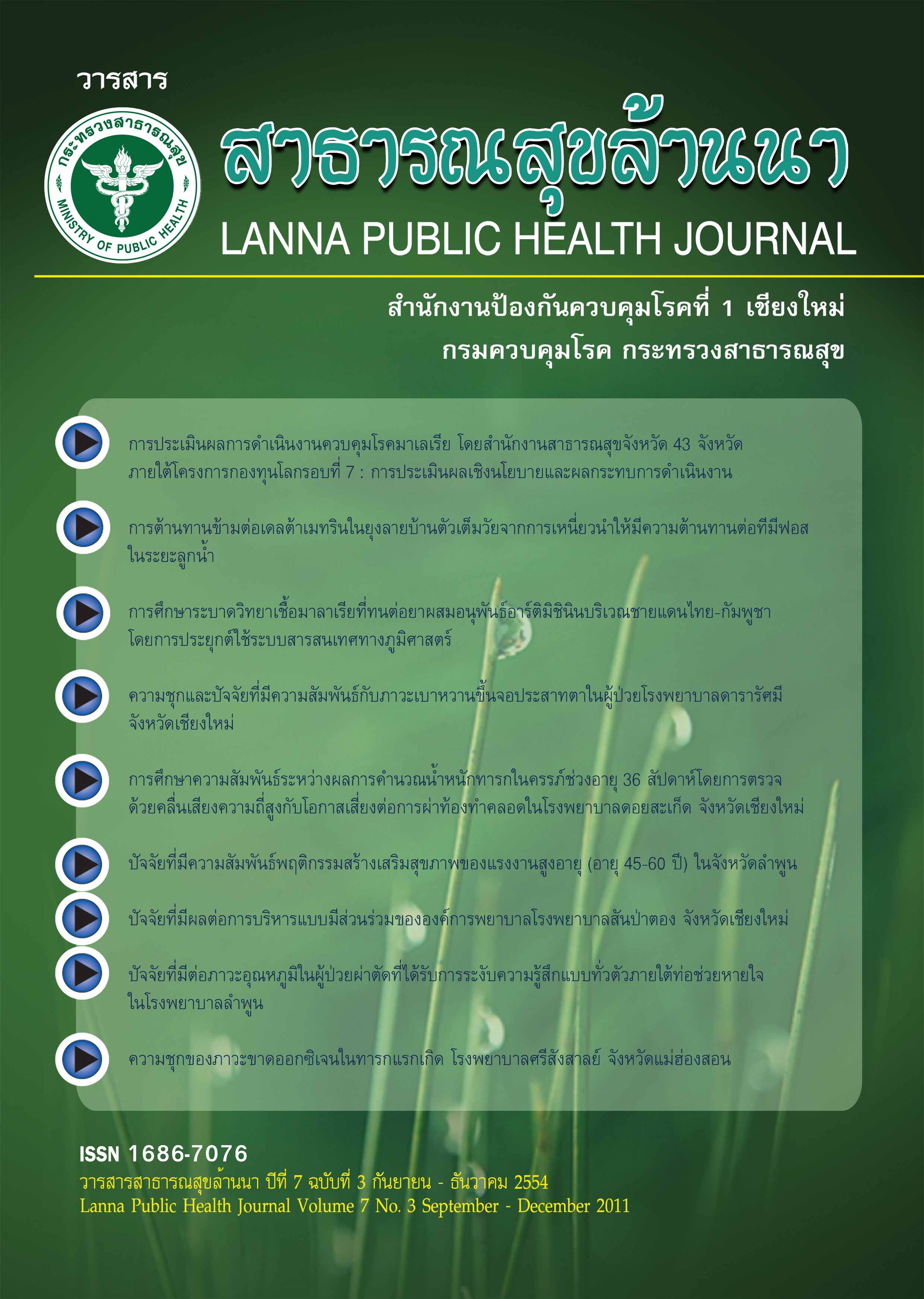ปัจจัยเสี่ยงที่มีต่อภาวะอุณหภูมิในผู้ป่วยผ่าตัดที่ได้รับการระงับความรู้สึกแบบทั่วตัวภายใต้ท่อช่วยหายใจ ในโรงพยาบาลลำพูน
คำสำคัญ:
ลักษณะปัจจัยเสี่ยง, ภาวะอุณหภูมิกายต่ำ, การระงับความรู้สึกแบบทั่วตัวบทคัดย่อ
ภาวะอุณหภูมิร่างกายต่ำกว่า 36°C (96.8°F) ขณะผ่าตัดทำให้เกิดภาวะแทรกซ้อนต่างๆ เช่น การทำงานของหัวใจผิดปกติ การสลายฤทธิ์ยาใช้เวลานานขึ้น การทำงานของเกล็ดเลือดผิดปกติ เพิ่มการสูญเสียเลือด แผลหายช้า แผลติดเชื้อ ผู้ป่วยตื่นช้า อยู่โรงพยาบาลนาน และเพิ่มค่าใช้จ่ายในการรักษา การศึกษานี้เป็นการศึกษาแบบ This Cross-sectional study เพื่อศึกษาลักษณะปัจจัยเสี่ยงต่อภาวะอุณหภูมิกายต่ำขณะผ่าตัดของผู้ป่วยที่ได้รับการระงับความรู้สึกแบบทั่วตัวภายใต้การใส่ท่อหายใจ ในโรงพยาบาลลำพูน กลุ่มศึกษาเป็นผู้ป่วยที่เข้ารับการผ่าตัดไม่ฉุกเฉินจำนวน 202 ราย วิเคราะห์เปรียบเทียบกลุ่มที่เกิดภาวะอุณหภูมิกายต่ำ กับกลุ่มที่ไม่เกิดภาวะอุณหภูมิกายต่ำด้วยสถิติ Chi-square test, t-test และวิเคราะห์ลักษณะปัจจัยเสี่ยงด้วยlogistic regression ผลการศึกษาพบว่า ลักษณะปัจจัยเสี่ยงที่มีนัยสำคัญทางสถิติ ได้แก่ เพศชาย (RR=2.72, 95%CI=1.36-5.42) อายุมากกว่า 45 ปี (RR=3.21, 95%CI=1.50-6.85) ภาวะอุณหภูมิกายต่ำเกิดเมื่ออุณหภูมิห้องผ่าตัดต่ำกว่า 21°C และเกิดหลังจากให้การระงับความรู้สึกไปแล้ว 45 นาที ควรเฝ้าระวังและป้องกันการเกิดภาวะอุณหภูมิกายต่ำในผู้ป่วยผ่าตัดที่เป็นเพศชายอายุมากกว่า 45 ปีขึ้นไป ผ่าตัดในห้องที่มีอุณหภูมิห้องที่ต่ำกว่า 21°C และหลังจากให้การระงับความรู้สึกไปแล้ว 45 นาที
เอกสารอ้างอิง
Baleri CR, Cassidy G, Khui S, et al. Hypothermia-induced reversible platelet dysfunction Ann Surg 1987; 205: 175-81.
Berlin B, Shavit Y, Razumovsky J, Wolloch Y, Zeidel A, Bessler H. Effect of mild perioperative hypothermia on cellular immune responses Anesthesiology 1998; 89: 1133-40.
Bush H Jr, Hydo LJ, Fisher E, et al. Hypothermia during elective abdominal aortic aneurysm repair: The high price of avoidable morbidity. J Vasc Surg 1995; 21: 392-402.
Frank SM, Beattie E, Christopherson R, Norris ES, Perler BA, Williams GM, Gottieb SO. Unintentional hypothermia is associated with postoperative myocardial ischemia.
Anesthesiology 1993; 79: 468-76.
Frank SM, Fleisher LA, Breslow MJ, Higgins NS, Olson KF, Keyyls, Beattie C. Perioperative maintenance of normothermia reduce the incidence of morbid cardiac event: A
randomized clinical trial. JAMA 1991; 277: 1127-34.
Heier T, Caldwell JE, Deddler DI, Miller Rd. Mild intraoperative hypothermia increase duration of action and spontaneous recovery of vecuronium blockde during nitrous oxide-Isofluran anesthesia in humans. Anesthesiology 1991; 74: 815-9.
Hypothermia guidline for the prevention of unplan perioperative hypothermia. American Society of Peri-Anesthesia Nurses. Avilable on http//www.aspan.org/ Hypothermia.htm. Acessed on March 5, 2007.
Kitamura A, Hosjino T, Kon T, Ogaw R. patient with diabetic neuropathy are risk of a greater intraoperative reduction in core temperature. Anesthesiology 2000; 92: 1311-8.
Kurz A, Plattner O, Sessler DI, Heumer G, Redi G, Lackner F. The threshold for thermoregulatory vasoconstriction during nitrous oxide/isoflurane anesthesia is lower in eldery than in young patient. Anesthesiology 1993; 79: 465-9
Kurz A, Sessler DI, Lenhardt RA. Study of wound infection and temperature group. Perioperative normothermia to reduce the incidence of surgical wound infection and
shorten hospitalization. N Engl J Med 1996; 334: 1209-15.
Leslie K, Sessler DI, Bjorkten AR, Moayeri A. Mild hypothermia after propofal pharmacokinetics and increase the duration of action of a tracurium Anesth Analq
1995; 80: 1007-14.
Matsukawa T, Sessler DI, Schroeder M, Ozaki M, Kurz A. Heat flow and distribution during induction of general anesthesia. Anesthesiology 1995; 82: 662-73.
Panagiotis K, Maria P, Argiri P, Panagiotis S. Is postanesthesia care unit length of stay increased in hypothermia patient AORN J. 2005; 82: 379-85.
Schmied H, Kurz A, Sessler DI, KozekS, Reiter A. Mild intraoperative hypothermia increases blood loss and allogeneic transfusion requirement during total hip arthroplasty.
Lancet 1996; 347: 289-92.
Vaugham MS, Vaugham RW, Cork Rc. Postoperative hypothermia in adults: relationship of age, anesthesia, and shivering to rearming. Anesth Anal 1981; 60: 746-52.








